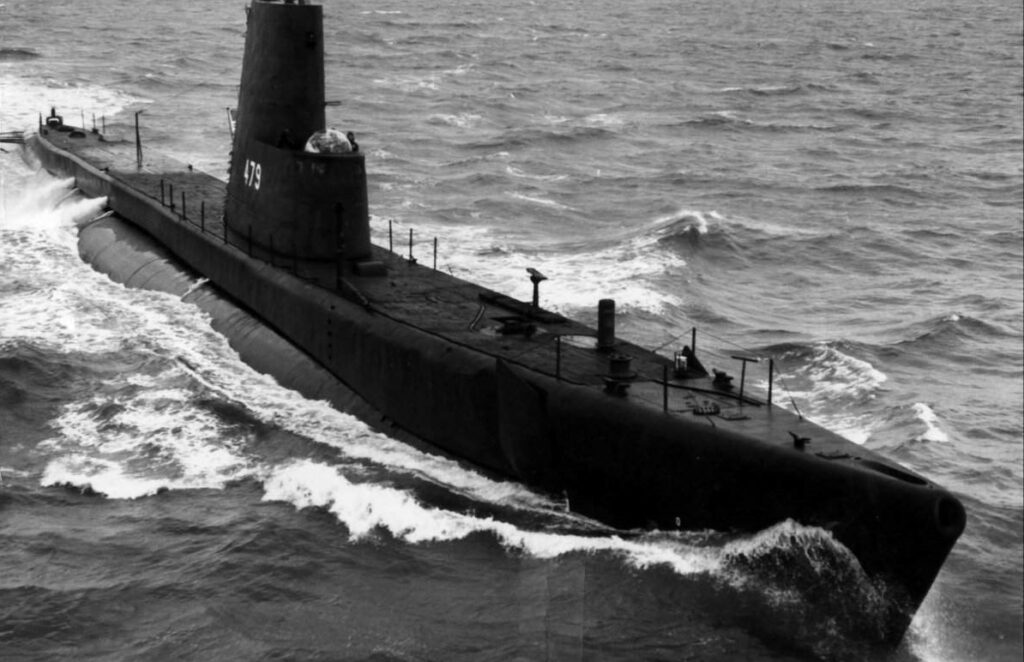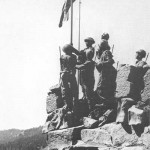
0n 21 February 2024, Indian Naval Deep Submergence Rescue Vehicle (DSRV) located the wreckage of SS-102 PNS Ghazi, once the pride of the Pakistan Navy that was sunk on 4 December 1971 by the Indian Navy during the Indo-Pakistan War of 1971. Ghazi had been sleeping peacefully at the depth of 100 metres below sea level about 3 kms off the coast near Vizag port in Andhra Pradesh for the last 53 years.
India is one of few nations which have acquired DSRV capability. Indian Navy currently has two DSRV teams commissioned in 2018 and 2019 serving in Eastern and Western Naval command. The equipment had been procured from James Fisher Defence United Kingdom. These submersible wonders can operate as deep as 700 metres and detect in the radius of one km around it and constantly operate for 3 hours. DSRV 1 reached the site of wreckage of PNS Ghazi last week, watched it through HD cameras but did not disturb the sleeping warriors of our enemy nation.
PNS Ghazi was originally a US Navy Tench Class Diesel Electric Submarine of World War-II vintage whose original name was USS Diablo (Hull number SS-479). It had been inducted in to service on 31 March 1945. Diablo means a dreaded Devil. USS Diablo was handed over to the Pakistan Navy on lease in 1963 and later gifted to the country. Pakistan Navy commissioned it as PNS Ghazi (Holy warrior) and allotted a new Hull number (S-130 SJ) on 1 June 1964.
PNS Ghazi was a Cigar shaped fast attack submarine with very long endurance to remain underwater. The U-boat was 95-metre-long and had a draft height of 5.2 metre and displacement of 2453 tons when submerged. Four Fairbanks Morse 38D8 10 cylinder opposed piston diesel engines powered the electric generators along with two low speed Elliot motors. The thrust was provided by two powerful propellers of 5400 horsepower (4 mw) and 2740 horsepower (2 mw) each. The boat could cruise at 25 Knots (37.5 Km per hour) in high seas and at 10 knots if submerged. The Submarine had to surface to release toxic gases after 48 hours. The cruising range of Ghazi was 11000 nautical miles. The main Armament was 10 x533mm Torpedo tubes. 28 Torpedoes and secondary weapons were one 5 inch calibre deck gun, two 40mm cannons, two 7.62mm Machineguns and it could lay underwater M I4 anti-ship mines. It could operate for 73 days continuously without docking. The maximum depth it can dive was 400 feet (120 metres).
SS- 102 operated in Indo Pak War of 1965 in the Arabian Sea and escorted the Pakistan Naval task force attack on Radar station at Port of Dwarka/Okha off the coast of Gujarat in the Gulf of Kutch under Commander Karamat Rahman Niazi. Subsequently, its main target was INS Vikrant and other Indian warships operating in the War zone of the Arabian sea. Vikrant could not be located.
On 9 September 1965, Ghazi was detected by INS Beas which used depth charges but the submarine dived deep and escaped. On 17 September, it fired three torpedoes at INS Brahmaputra, another destroyer and claimed hits but INS Brahmaputra sailed home safely.
After the war, Ghazi also docked safely. Commander K R Niazi was decorated with Sitara-e-Jurat while the submarine was awarded with President’s citation. Nine more bravery awards given to other crew members. Lieutenant Zafar Muhmmad was the navigation officer of Ghazi in 1965
In 1967 during annual maintenance Inspection, it was pointed out that vessel required overhaul. Accordingly, it had to be sent to nearest Shipyard capable of carrying out Base overhaul and modifications which was Izmir port, Turkey, an ally of Pakistan and USA.
The modified PNS Ghazi was now armed with new 28 x Mk 14 Torpedoes, Mine laying capability and new computers. Fully refurbished, it sailed home but as Suez Canal was blocked due to Arab-Israel War, it had to circumnavigate submerged from Atlantic to Indian Ocean around Cape of Good Hope under the command of new commanding officer Lt Commander Yousaf Raza. It docked safely at Karachi on 2 April 1970
When Pakistajn went to war against India in 1971, PNS Ghazi was mobilised and tasked to head for Chittagong port in Bay of Bengal and hunt for INS Vikrant. The Indian flag ship was transferred to newly raised Indian Eastern Naval command in August 1971 and was operating in the Bay of Bengal. Initially, It was docked for a month at Madras port but later moved to Vishakhapatnam on the eastern coast of Andhra Pradesh with a task to establish blockade to Chittagong operations.
Lt Commander Zafar Muhammad, who was Navigation officer in the 1965 War, was appointed as commanding officer of PNS Ghazi on 1 October 1971. He was an expert in submarine warfare and totally motivated. All external and internal checks were carried out.
On 13 November 1971, as the sun was disappearing in the western horizon, a fond farewell was given to crew of 11 Officers and 82 Sailors with Military band playing the national anthem, Jeeve, Jeeve Pakistan (Long Live Pakistan). The Naval Chief had come to see off the PNS Ghazi as it embarked on its long journey to the battle field of Bay of Bengal.
PNS Ghazi quietly left the port of Karachi on early morning of 14 November at 0400h for its final journey in the Indian Ocean. Before daylight, it submerged and headed south on plotted course in the Arabian sea cruising at the speed of 20 knots/hour. On 16 November 1971, PNS Ghazi location coordinates communicated by Cdr Zafar Khan to Pakistan Naval HQ were 400 kms west of Bombay port heading for Colombo. it crossed Colombo on 18 November midnight and skirted the Sri Lankan southern coast line to entered Indian Ocean near Hambantota, yet another Sri Lankan port on 19 November. The Submarine now turned North and entered Bay of Bengal on 20 November1971.
Pakistan Naval HQ now instructed Commander Zafar to open Top Secret file and directed him to undertake following mission. Firstly, locate INS VIKRANT and destroy it and secondly, lay mines on the exit/entry funnels of Ports of Madras and Vizag. On 23 November, Ghazi had already covered 3500 kms and was near Madras port when Pakistan Naval HQ had last contact with the submarine. Ghazi maintained total radio silence till 3 December 1971.
Indian Navy was already alerted by IB that PNS Ghazi was heading for Bay of Bengal and hunting for INS Vikrant. A deception plan was made was made by Vice Admiral Nilakanth Krishnan. INS Rajput, a British origin destroyer, commanded by Lt Commander Inder Singh, was given the code sign of Vikrant and all messages were originated as if they were from Vikrant like demand for Lubricants, ammunition and enhanced Rations strength etc. Meanwhile, INS Vikrant full steam headed for a secret Andaman Naval base on 1 November 1971 and reached its hide out on 15 November 1971 well before Ghazi entered Bay of Bengal.
Initially, Ghazi searched around Madras port looking for Aircraft carrier, later, it, headed for Vizag port to lay ambush for Vikrant or other Indian Naval ships leaving Vizag port and got busy in laying mines. On 3 December, it was located just 4 kms from Vizag main land ready to torpedo Vikrant or other opportunity targets. Meanwhile, Port Defence HQ of Vizag on information of IL 38 Maritime surveillance aircraft ordered INS Rajput to look for a Pakistan submarine and undertake precautionary measures.
On midnight of 3-4 December, INS Rajput commanded by Commander Inder Singh as directed by Eastern Naval command dropped several depth charges, while sweeping the area. Several loud explosions were heard and seen by Ships docked in the harbour and coastal defence batteries.
PNS Ghazi was trapped and blown up by a combination of depth charges and its own Armed torpedoes and met its eternal watery grave 3 kms off the coast of VIizag. The entire crew of 93 including Commander Zafar were killed as the U-boat sank almost 100 metres deep on bottom of the Sea. Indian Navy was also not aware till 4 December mid-day when the local fishermen informed about oil spillage on the port mouth and recovery of a lot of life jackets, lob books that were floating in the sea. PNS Ghazi was the first Naval casualty of Indo-Pakistan War of 1971. Its destruction was a big blow to the Pakistan Navy as its pride was demolished on the first day of the war. INS Nistar conducted deep search with help of divers but there were no survivors.
After DSRV located the wreckage, the remains were not disturbed since there is a naval ethos that sea warriors resting in peace under water are not disturbed.
Courtesy: https://defenceinfo.com/the-last-voyage-of-pakistani-naval-ship-ghazi/





Pakistan Navy Submarine PNS Ghazi came to the Bay of Bengal to assist the Genocidal-Murderous Pakistan Armed Forces in occupied-Bangladesh.
However, Indian Armed Forces & Indian Navy buried Jinna’s ‘2-Nation Theory’ and Pakisan Navy’s PNS Ghazi Submarine thousand foot deep into the Bay of Bengal On midnight of 3-4 December, 1971.
PNS Ghazi crews now roasting in Jahannam Fire.
1971 Bangladesh Liberation Struggle showed that DARPOOK P@kistan Army/ Air Force/ Navy morale would not stand more than a couple of hard blows at the right time and place.